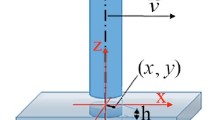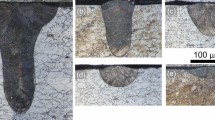Abstract
This paper focuses on improving the melt pool geometry predictions and quantifying uncertainties using an adapted version of the Eagar–Tsai (E–T) model that incorporates temperature-dependent properties of the material as well as powder conditions. Additionally, Bayesian inference is employed to predict distributions for the E–T model input parameters of laser absorptivity and powder bed porosity by incorporating experimental results into the analysis. Monte Carlo uncertainty propagation is then used with these parameter distributions to estimate the melt pool depth and associated uncertainty. Our results for the 316L stainless steel suggest that both the absorptivity and powder bed porosity are strongly influenced by the laser power. In contrast, the scanning speed has only a marginal effect on both the absorptivity and powder bed porosity. We constructed a printability map using the Bayesian E–T model based on power-dependent input parameter values to demonstrate the merit of the approach. The Bayesian approach improved the accuracy in predicting the keyhole regions in the laser power-scan speed parameter space for the 316L stainless steel. Although applied to a specific adaptation of the E–T model, the method put forth can be extended to quantify uncertainties in other numerical models as well as in the estimation of unknown parameters.









Similar content being viewed by others
References
Bertoli US, Wolfer AJ, Matthews MJ, Delplanque JPR, Schoenung JM (2017) On the limitations of volumetric energy density as a design parameter for selective laser melting. Mater Des 113:331. https://doi.org/10.1016/j.matdes.2016.10.037
Kamath C (2016) Data mining and statistical inference in selective laser melting. Int J Adv Manuf Technol 86:1659. https://doi.org/10.1007/s00170-015-8289-2
Bassoli E, Sola A, Celesti M, Calcagnile S, Cavallini C (2018) Development of laser-based powder bed fusion process parameters and scanning strategy for new metal alloy grades: a holistic method formulation. Materials 11:2356. https://doi.org/10.3390/ma11122356
Tan JH, Wong WLE, Dalgarno KW (2017) An overview of powder granulometry on feedstock and part performance in the selective laser melting process. Addit Manuf 18:228. https://doi.org/10.1016/j.addma.2017.10.011
Oliveira J, LaLonde A, Ma J (2020) Processing parameters in laser powder bed fusion metal additive manufacturing. Mater Des 193:108762. https://doi.org/10.1016/j.matdes.2020.108762
Cunningham R, Zhao C, Parab N, Kantzos C, Pauza J, Fezzaa K, Sun T, Rollett AD (2019) Keyhole threshold and morphology in laser melting revealed by ultrahigh-speed x-ray imaging. Science 363(6429):849. https://doi.org/10.1126/science.aav4687
Tan W, Shin YC (2014) Analysis of multi-phase interaction and its effects on keyhole dynamics with a multi-physics numerical model. J Phys D Appl Phys 47:345501. https://doi.org/10.1088/0022-3727/47/34/345501
Johnson L, Mahmoudi M, Zhang B, Seede R, Huang X, Maier JT, Maier HJ, Karaman I, Elwany A, Arróyave R (2019) Assessing printability maps in additive manufacturing of metal alloys. Acta Materialia 176:199. https://doi.org/10.1016/j.actamat.2019.07.005
Rosenthal D (1946) The theory of moving sources of heat and its application to metal treatments. Trans Am Soc Mech Eng 68(8):849
Eagar TW, Tsai NS (1983) Temperature fields produced by traveling distributed heat sources. Weld Res Suppl 62:346–355
Carter MJ, El-Desouky A, Andre MA, Bardet P, LeBlanc S (2019) Pulsed laser melting of bismuth telluride thermoelectric materials. J Manuf Process 43:35. https://doi.org/10.1016/j.jmapro.2019.04.021
Mondal S, Gwynn D, Ray A, Basak A (2020) Investigation of melt pool geometry control in additive manufacturing using hybrid modeling. Metals 10(5):683. https://doi.org/10.3390/met10050683
Kim CS (1975) Thermophysical properties of stainless steels. Technical report, Argonne National Lab., IL (USA)
Trapp J, Rubenchik AM, Guss G, Matthews MJ (2017) In situ absorptivity measurements of metallic powders during laser powder-bed fusion additive manufacturing. Appl Mater Today 9:341. https://doi.org/10.1016/j.apmt.2017.08.006
Boley CD, Mitchell SC, Rubenchik AM, Wu SSQ (2016) Metal powder absorptivity: modeling and experiment. Appl Opt 55(23):6496. https://doi.org/10.1364/AO.55.006496
Watson TW, Robinson HE (1963) Thermal conductivity of a sample of type 316L stainless steel. Technical Report 7818, NBS Heat Transfer Section, National Bureau of Standards, U. S. Dept. of Commerce, Washington, D. C. https://doi.org/10.6028/NBS.RPT.7818
Saxena S, Chen S (1975) Thermal conductivity of nitrogen in the temperature range 350-2500 K. Mol Phys 29(5):1507. https://doi.org/10.1080/00268977500101321
Pal R (2008) On the Lewis–Nielsen model for thermal/electrical conductivity of composites. Compos Part A Appl Sci Manuf 39(5):718. https://doi.org/10.1016/j.compositesa.2008.02.008
King WE, Anderson AT, Ferencz RM, Hodge NE, Kamath C, Khairallah SA, Rubenchik AM (2015) Laser powder bed fusion additive manufacturing of metals; physics, computational, and materials challenges. Appl Phys Rev 2(4):041304. https://doi.org/10.1063/1.4937809
Rubenchik A, Wu S, Mitchell S, Golosker I, LeBlanc M, Peterson N (2015) Direct measurements of temperature-dependent laser absorptivity of metal powders. Appl Opt 54(24):7230. https://doi.org/10.1364/AO.54.007230
Zhu H, Fuh J, Lu L (2007) The influence of powder apparent density on the density in direct laser-sintered metallic parts. Int J Mach Tools Manuf 47(2):294. https://doi.org/10.1016/j.ijmachtools.2006.03.019
Martin AA, Calta NP, Khairallah SA, Wang J, Depond PJ, Fong AY, Thampy V, Guss GM, Kiss AM, Stone KH, Tassone CJ, Nelson Weker J, Toney MF, van Buuren T, Matthews MJ (2019) Dynamics of pore formation during laser powder bed fusion additive manufacturing. Nat Commun 10(1):1987
Guo Q, Zhao C, Escano LI, Young Z, Xiong L, Fezzaa K, Everhart W, Brown B, Sun T, Chen L (2018) Transient dynamics of powder spattering in laser powder bed fusion additive manufacturing process revealed by in-situ high-speed high-energy x-ray imaging. Acta Materialia 151:169. https://doi.org/10.1016/j.actamat.2018.03.036
Nikam SH, Quinn J, McFadden S (2021) A simplified thermal approximation method to include the effects of Marangoni convection in the melt pools of processes that involve moving point heat sources. Numer Heat Transf Part A Appl 79(7):537
Rammos P (2020) Numerical framework for selective laser melting processing of thermoelectric materials. Master’s thesis, George Washington University (2020)
Bayes T (1763) LII. An essay towards solving a problem in the doctrine of chances. Philos Trans R Soc Lond 53:370. https://doi.org/10.1098/rstl.1763.0053
Hamada MS, Higdon DM, Abes J, Hills C, Peters AM (2015) Illustrating how science can be incorporated into a nonlinear regression model. Quality Eng 27(4):416. https://doi.org/10.1080/08982112.2015.1023314
Spiegelhalter D, Rice K (2009) Bayesian statistics. Scholarpedia 4(8):5230. https://doi.org/10.4249/scholarpedia.5230 (Revision 185711)
Xue D, Balachandran PV, Yuan R, Hu T, Qian X, Dougherty ER, Lookman T (2016) Accelerated search for BaTiO3-based piezoelectrics with vertical morphotropic phase boundary using Bayesian learning. Proc Natl Acad Sci 113(47):13301. https://doi.org/10.1073/pnas.1607412113
Fancher CM, Han Z, Levin I, Page K, Reich BJ, Smith RC, Wilson AG, Jones JL (2016) Use of Bayesian inference in crystallographic structure refinement via full diffraction profile analysis. Sci Rep 6(1):31625. https://doi.org/10.1038/srep31625
Kim H, Inoue J, Kasuya T, Okada M, Nagata K (2020) Bayesian inference of ferrite transformation kinetics from dilatometric measurement. Comput Mater Sci 184:109837. https://doi.org/10.1016/j.commatsci.2020.109837
Hartig F, Minunno F, Paul S (2019) BayesianTools: general-purpose MCMC and SMC samplers and tools for Bayesian statistics. https://CRAN.R-project.org/package=BayesianTools. R package version 0.1.7
Albert DR (2020) Monte Carlo uncertainty propagation with the NIST uncertainty machine. J Chem Educ 97(5):1491. https://doi.org/10.1021/acs.jchemed.0c00096
Ning J, Sievers DE, Garmestani H, Liang SY (2019) Analytical modeling of in-process temperature in powder bed additive manufacturing considering laser power absorption, latent heat, scanning strategy, and powder packing. Materials 12(5):808. https://doi.org/10.3390/ma12050808
Seede R, Shoukr D, Zhang B, Whitt A, Gibbons S, Flater P, Elwany A, Arróyave R, Karaman I (2020) An ultra-high strength martensitic steel fabricated using selective laser melting additive manufacturing: densification, microstructure, and mechanical properties. Acta Materialia 186:199. https://doi.org/10.1016/j.actamat.2019.12.037
Chen Y, Wang H, Wu Y, Wang H (2020) Predicting the printability in selective laser melting with a supervised machine learning method. Materials 13:5063. https://doi.org/10.3390/ma13225063
Tenbrock C, Fischer FG, Wissenbach K, Schleifenbaum JH, Wagenblast P, Meiners W, Wagner J (2020) Influence of keyhole and conduction mode melting for top-hat shaped beam profiles in laser powder bed fusion. J Mater Process Technol 278:116514. https://doi.org/10.1016/j.jmatprotec.2019.116514
Acknowledgements
This material is based upon work supported by the US Department of Energy’s Office of Energy Efficiency and Renewable Energy (EERE) under the Advanced Manufacturing Office Award Number DE-EE0009100. This report was prepared as an account of work sponsored by an agency of the US Government. Neither the US Government nor any agency thereof, nor any of their employees, makes any warranty, express or implied, or assumes any legal liability or responsibility for the accuracy, completeness, or usefulness of any information, apparatus, product or process disclosed, or represents that its use would not infringe privately owned rights. Reference herein to any specific commercial product, process, or service by trade name, trademark, manufacturer, or otherwise does not necessarily constitute or imply its endorsement, recommendation, or favoring by the US Government or any agency thereof. The views and opinions of authors expressed herein do not necessarily state or reflect those of the US Government or any agency thereof. B.J.W and P.V.B thank Mr. Nicholas Wu for insightful comments on the manuscript.
Author information
Authors and Affiliations
Corresponding author
Ethics declarations
Conflict of interest
The authors declare that they have no conflict of interest.
Supplementary Information
Below is the link to the electronic supplementary material.
Rights and permissions
About this article
Cite this article
Whalen, B.J., Ma, J. & Balachandran, P.V. A Bayesian Approach to the Eagar–Tsai Model for Melt Pool Geometry Prediction with Implications in Additive Manufacturing of Metals. Integr Mater Manuf Innov 10, 597–609 (2021). https://doi.org/10.1007/s40192-021-00238-z
Received:
Accepted:
Published:
Issue Date:
DOI: https://doi.org/10.1007/s40192-021-00238-z




